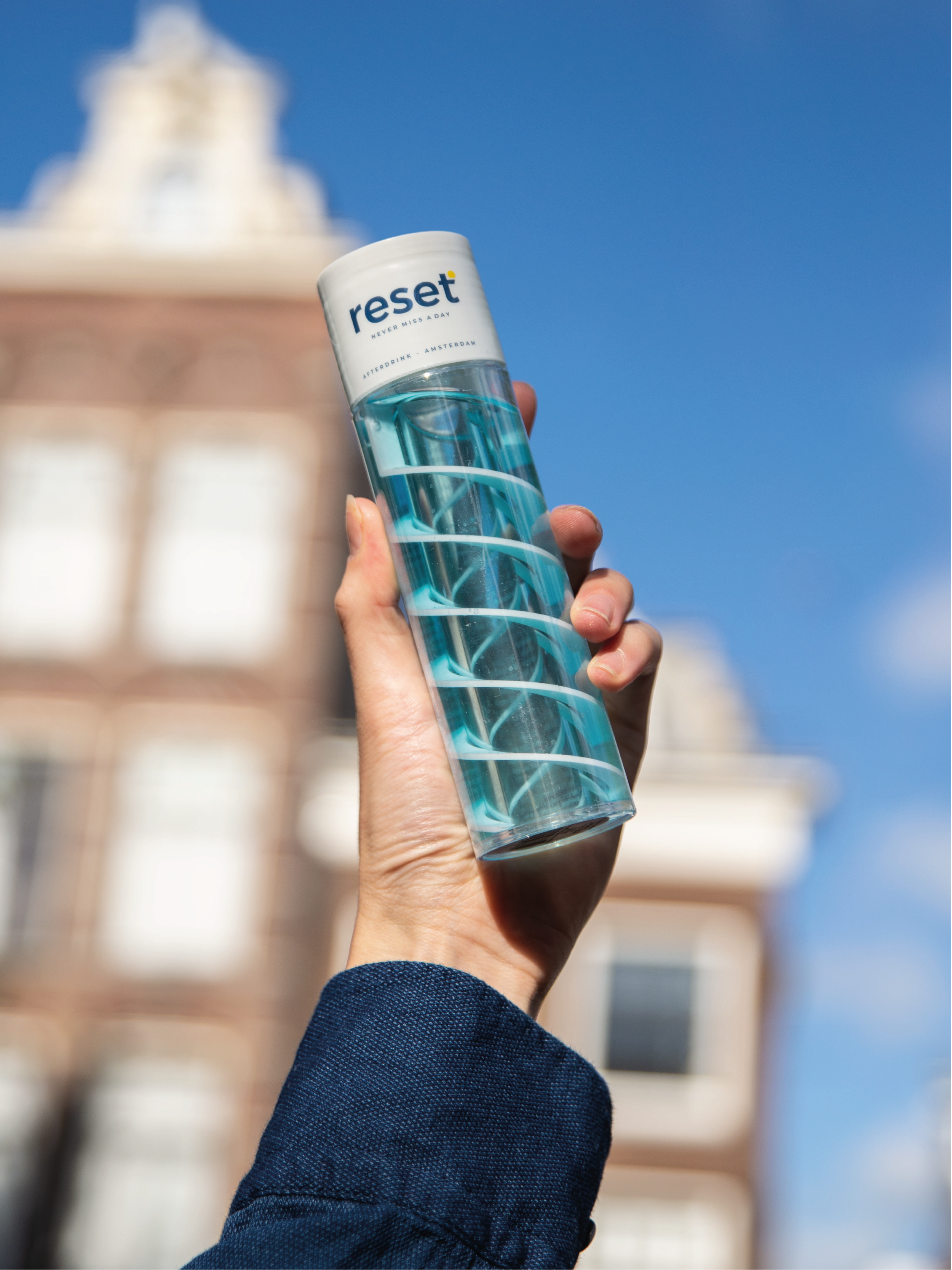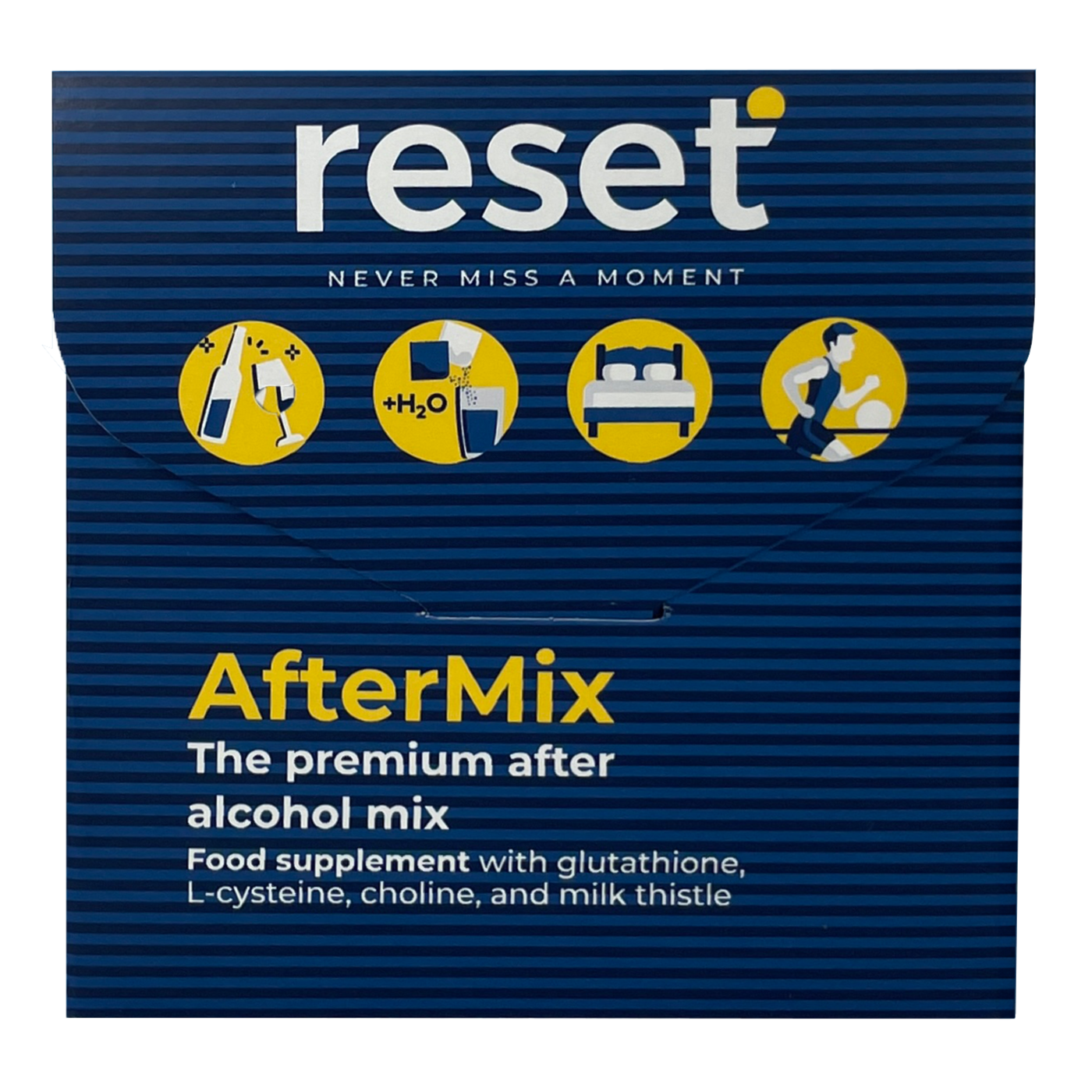From the moment you consume alcohol, your body starts working hard to process it. Alcohol is roughly broken down in three steps:

Step 1
The liver and stomach break down alcohol into acetaldehyde. Acetaldehyde is a toxic irritant that damages organs, cells, and even DNA, and is responsible for causing hangovers.
Step 2
The liver breaks down acetaldehyde into acetic acid.
Step 3
Acetic acid is converted into energy, glucose, or fatty acids.
Not every step is completed at the same speed, with the second step being the slowest. During this stage, acetaldehyde is broken down, but it happens very slowly, leading to an accumulation of this toxic substance.
Reset AfterDrink and Reset AfterMix provides the body with the right nutrients to help accelerate this process.
Step 1
The liver and stomach break down alcohol into acetaldehyde. Acetaldehyde is a toxic irritant that damages organs, cells, and even DNA, and is responsible for causing hangovers.
Step 2
The liver breaks down acetaldehyde into acetic acid.
Step 3
Acetic acid is converted into energy, glucose, or fatty acids.
Not every step is completed at the same speed, with the second step being the slowest. During this stage, acetaldehyde is broken down, but it happens very slowly, leading to an accumulation of this toxic substance.
Reset AfterDrink and Reset AfterMix provides the body with the right nutrients to help accelerate this process.

What happens in every step?
Step 1
How is alcohol broken down in the body?
Alcohol is mainly broken down by the liver and partly in the stomach. The liver takes about 1 to 1.5 hours to break down 1 standard glass of alcohol. So, if you consume 8 glasses, the liver will be busy breaking down the alcohol for 8 to 12 hours. This means that even the morning after heavy drinking, you still have alcohol in your bloodstream.
Alcohol dehydrogenase (ADH) is an enzyme responsible for breaking down alcohol in our body. It converts ethanol into a toxic substance called acetaldehyde. This happens by removing a hydrogen atom from ethanol, converting it into acetaldehyde. This enzyme plays a crucial role in processing alcohol in our system.
- From alcohol consumption to energy -
Step 2
How is acetaldehyde broken down?
Acetaldehyde is a toxic substance often referred to as a radical. It damages organs, cells, and even DNA, contributing to hangover symptoms. Our body has enzymes and antioxidants available to capture and remove various radicals. However, after alcohol consumption, an abnormal amount of acetaldehyde is produced, overwhelming the body's ability to process it all. This accumulation is the main culprit for the hangover.
>>

Acetaldehyde dehydrogenase (ALDH) is an enzyme that plays a crucial role in breaking down acetaldehyde. It converts the toxic acetaldehyde into acetic acid. This happens by removing a hydrogen atom from acetaldehyde, converting it into acetic acid. ALDH helps reduce the harmful effects of acetaldehyde. Glutathione also plays a crucial role in the body's detoxification processes alongside ALDH. It helps neutralize toxic substances, bind heavy metals, and promote the elimination of harmful substances from the body. Glutathione, a tripeptide consisting of the amino acids glutamic acid, cysteine, and glycine, acts as an antioxidant and aids in neutralizing harmful substances like acetaldehyde. Glutathione binds to acetaldehyde, forming a non-toxic compound called glutathione-acetaldehyde adduct. This helps reduce the harmful effects of acetaldehyde by stabilizing and inactivating it.
Acetaldehyde dehydrogenase (ALDH) is an enzyme that plays a crucial role in breaking down acetaldehyde. It converts the toxic acetaldehyde into acetic acid. This happens by removing a hydrogen atom from acetaldehyde, converting it into acetic acid. ALDH helps reduce the harmful effects of acetaldehyde. Glutathione also plays a crucial role in the body's detoxification processes alongside ALDH. It helps neutralize toxic substances, bind heavy metals, and promote the elimination of harmful substances from the body. Glutathione, a tripeptide consisting of the amino acids glutamic acid, cysteine, and glycine, acts as an antioxidant and aids in neutralizing harmful substances like acetaldehyde. Glutathione binds to acetaldehyde, forming a non-toxic compound called glutathione-acetaldehyde adduct. This helps reduce the harmful effects of acetaldehyde by stabilizing and inactivating it.

Step 3
How is acetic acid broken down in the body?
Acetic acid, formed by ALDH, can be processed in various ways in our body. It can enter the tricarboxylic acid cycle (TCA cycle) where it is broken down into carbon dioxide and hydrogen ions. This process also produces energy in the form of ATP. Acetic acid can also be converted into glucose, an important fuel for our body, through a process called gluconeogenesis. Additionally, acetic acid can be used to form fatty acids, which are used for the synthesis of lipids and fat storage. Some of the acetic acid can be excreted through urine or respiration.
In summary, alcohol is broken down by ADH into acetaldehyde, and then acetaldehyde is converted by ALDH into acetic acid. Acetic acid can be used as fuel, produce glucose, or form fatty acids.
Reset and Refresh






